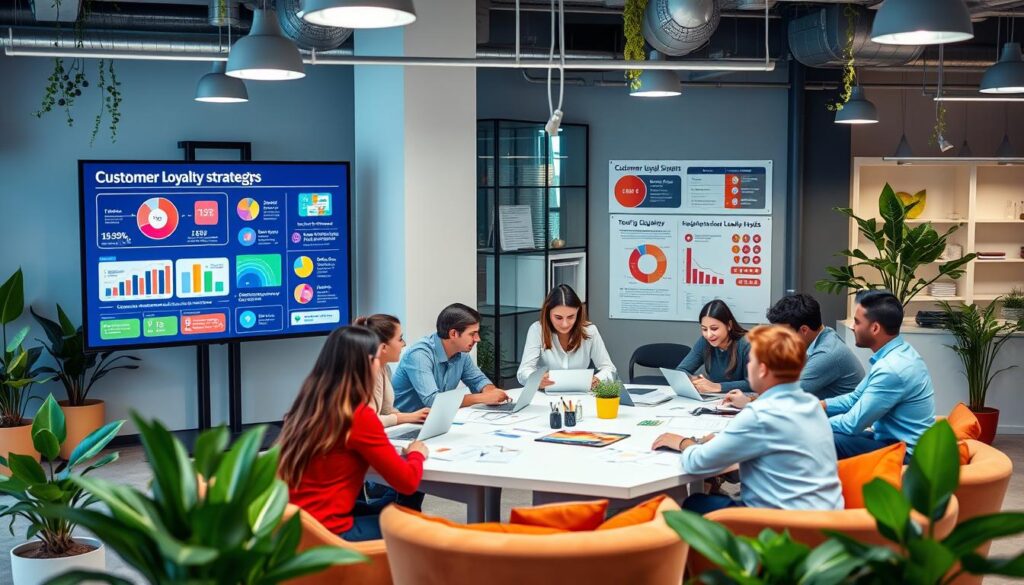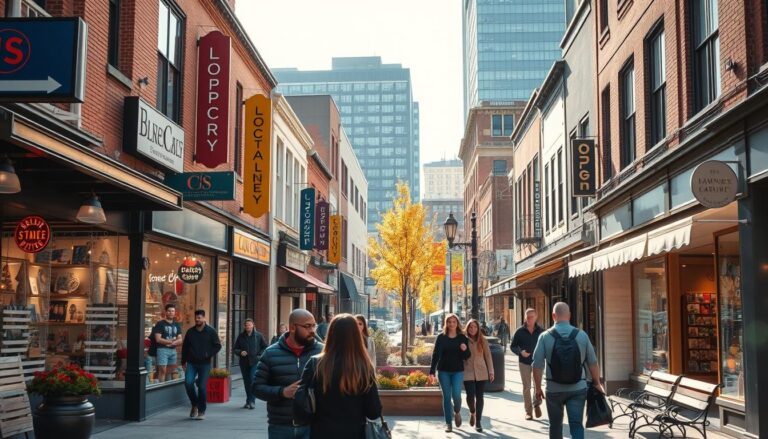In the competitive world we’re in, strong customer relationships are super important. This is why it’s crucial to increase customer retention rates. Surprisingly, making more money often comes from keeping existing customers happy, not just getting new ones. This shows how important it is to boost customer engagement and enhance brand loyalty. Companies need to work hard to keep their customers close as it helps keep the money flowing and growing.
Did you know that 20% of your current customers might bring in about 80% of your future profits? Keeping these customers is not just smart; it’s a must for your success. Customers want a great buying experience. When they get it, they stay loyal and tell others about your brand. This, in turn, improves your retention rates a lot.
Key Takeaways
- Customer retention essentials include enhancing the experience and engagement.
- Considering customer feedback leads to improved satisfaction and retention.
- Loyalty programs have immense power to foster sustained customer association.
- Online communities and technological tools like chatbots facilitate engagement.
- Product uniqueness and quality, along with competitive pricing, are pivotal for customer retention.
- Strategic brand differentiation aids in maintaining a devoted customer base.
- Customer Lifetime Value and Net Promoter Score are crucial metrics for loyalty and retention assessment.
Understanding Customer Retention and Its Importance
Customer retention is crucial for any business wanting to succeed in today’s market. Returning customers fuel steady revenue and enhance business stability.
What is Customer Retention?
Customer retention is about keeping customers from leaving. It involves engaging with them in ways that make them want to stay loyal. Success in retention marketing can lower the cost of gaining new customers.
The Benefits of Retaining Existing Customers
Keeping customers boosts their value and your profits. A 5% increase in retention can lead to a 75% profit boost. Happy customers often tell others, helping to bring in more business. This approach builds a supportive community around your brand.
Key Metrics to Measure Retention
Metrics like Customer Retention Rate (CRR), Net Promoter Score (NPS), and Customer Lifetime Value (CLV) are crucial. These metrics show the value customers bring to your business. For example, a CRR of 43.3% is low; aim for over 85%.
| Strategy | Effect On Retention Rate | Example Results |
|---|---|---|
| Segmentation | Improves targeting | More personalized experiences |
| Automated Emails | Re-engages inactive customers | Increase in activity rates |
| Upselling | Increases customer value | Higher spending by loyal customers |
| Referral Programs | Expands brand advocacy | Increases customer base and loyalty |
Effective retention strategies rely on understanding customer needs. By using data and refining strategies, companies can greatly enhance growth and longevity.
Identifying Factors Influencing Retention Rates
In the competitive market today, it’s vital to know what keeps customers coming back. Key factors include customer experience, the quality of products or services, and how things are priced. These are central to customer experience strategies. They help make customers happier and less likely to leave.

Customer Experience Factors
Offering great customer service leads to loyal customers. Now, more companies use advanced AI agents to improve interactions. This makes customer ties stronger.
Having a strong strategy for customer experience is key. It can mean the difference between keeping a happy customer and losing one.
Product/Service Quality
High quality in products or services makes a company stand out. It builds trust and shows reliability to customers. Constantly making products better and innovating keeps a company ahead. This helps in maintaining customer interest and reducing losses.
Pricing Strategies
Prices that are fair and competitive help keep customers. Whether it’s simple pricing or different levels of pricing, it matters. Getting the pricing right plays a big part in keeping customers.
| Strategy | Description | Impact on Customer Retention |
|---|---|---|
| Customer-Centric Culture | Focusing on customer needs and feedback throughout the organization | Increased satisfaction and loyalty |
| Data-Driven Personalization | Utilizing analytics to tailor experiences and communications | Higher relevance, boosting retention |
| Quality and Innovation | Continual improvement and adaptation of product/service offerings | Sustains competitive advantage, reducing churn |
Implementing Effective Loyalty Programs
To boost customer loyalty effectively, you need solid strategies. These should increase brand love and ensure your loyalty program succeeds.

Types of Loyalty Programs
It’s vital to know the different loyalty programs. You can choose one that fits your audience. From point systems to tiered rewards, each has unique benefits. They build stronger relationships and encourage shoppers to keep coming back.
Best Practices for Launching a Program
Starting a loyalty program is not just about rewards. It’s crafting an experience that feels special and worthwhile. Key steps include targeting your audience for tailored rewards and making the program fun with gamification. Special offers also make your brand more appealing.
Using tools like Accrue can help. They let you add perks like store credits to your loyalty setup. This boosts the average spend and customer value.
Measuring Program Success
The success of a loyalty program needs regular checks and updates. Look at how often people buy and what they spend. These figures show if your program is working.
Checking how the program changes customer actions is also key. More repeat buys and referrals mean it’s working well.
Focusing on customer loyalty is key for businesses today. A good loyalty program cuts down on finding new customers and keeps the ones you have happy. As these programs grow, they help keep customers and turn them into fans of your brand. This leads to lasting success.
Enhancing Customer Engagement and Communication
Today’s businesses need to improve how they interact with clients. This is key for better customer engagement and its perks. Good communication enhances these interactions. It makes customer talks personal and helps businesses grow.
Importance of Regular Communication
Regular and meaningful talks with customers are key. They make sure customers feel informed and valued. Using personalized CRM tools and smart marketing is a great way to do this. These methods help send the right messages at the right time, keeping customers loyal.
Utilizing Feedback for Improvement
Feedback is crucial for any business wanting to please its customers and create loyalty. It’s about listening and acting on what customers say. This turns ordinary buying into a special experience. Acting on feedback means better relationships with customers, which shows in their loyalty and trust.
Building a Community Around Your Brand
Creating a community helps increase customer involvement. Communities let customers connect with the brand and each other. This improves the customer experience and loyalty. Using user-generated content, forums, and social media helps grow this sense of community.
| Engagement Strategy | Expected Increase in Engagement | Impact on Revenue |
|---|---|---|
| Personalized Communication | 23% more spending | 22% in cross-sell revenue |
| Loyalty Programs | Higher retention rates | 38% in upsell revenue |
| Community Initiatives | Boost in customer trust | Increased lifetime value |
It’s clear that focusing on communication and community can really help a business. It increases customer happiness and profits. This leads to a cycle of engagement, loyalty, and growth for the company.
Leveraging Technology to Boost Retention
The digital world is always changing. Because of this, businesses are looking for new ways to keep their customers. They use a variety of tech tools to improve how they keep customers. Tools like CRM, personalized data, and automated support aren’t just new trends. They’re changing how businesses talk to their valued customers.
Customer Relationship Management (CRM) Tools
CRM software is key for good customer care. It gives a full view of customer interactions across different platforms. CRM tools help companies talk better with customers and understand their needs.
By using CRM, businesses can follow the customer’s journey. They can make experiences better suited to the customer and meet their needs before they even ask. This often means customers come back and stay loyal. A single view of the customer also makes marketing more personal, improving how often customers stick around.
Data Analytics for Personalization
Data tools are at the core of making things more personal for customers. These tools help offer the personalized experiences that customers expect today. With data from tools like Google Analytics and social media, companies can understand customer habits better.
This understanding allows for emails and web experiences that feel more personal. This kind of personal attention means businesses aren’t just there. They’re making a meaningful impact on their customers by matching their unique needs.
Automation in Customer Service
Automated support, like chatbots, is changing how we think about service. Live chat software leads to the happiest customers. This, in turn, helps bring in and keep more customers. Quick answers from chatbots mean customers find it easy and enjoyable to get help.
Automating things like follow-up emails or keeping track of transactions makes everything more efficient. This ensures customers always get the smooth, top-notch service they expect from brands they trust.
With these tech solutions, companies can do better at keeping customers. They’ll also lead the way in making customer experiences better. Effective use of technology links data gathering with personalization. This delivers an efficient and memorable customer experience.
FAQ
What is Customer Retention?
Customer retention means keeping your customers coming back. It’s about making them choose your brand every time. To do this, businesses need to offer great experiences that meet or go beyond what customers expect.
The Benefits of Retaining Existing Customers
Keeping existing customers helps make a business’s income more stable. These customers tend to spend more and promote your brand. It’s cheaper to keep them than to find new ones.
Key Metrics to Measure Retention
To track how well you keep customers, look at the Customer Retention Rate, Net Promoter Score, and Customer Lifetime Value. These figures show if your efforts are working or if changes are needed.
Customer Experience Factors
Factors that keep customers loyal include good customer service, user-friendly products, listening to feedback, and personal touches. A great customer experience is key for lasting loyalty.
Product/Service Quality
High-quality products or services make customers happy and give you an edge over competitors. This encourages customers to keep choosing your brand, which builds loyalty and a good reputation.
Pricing Strategies
Fair and clear pricing makes customers feel they’re getting their money’s worth. Offering good quality at reasonable prices builds trust and keeps them from leaving for cheaper options.
Types of Loyalty Programs
Loyalty programs can be point-based, offer tiered rewards, paid memberships, support causes, or make shopping fun. Each kind rewards customers in different ways, encouraging them to keep buying.
Best Practices for Launching a Program
When starting a loyalty program, know your customers well. Choose rewards they’ll like, keep things simple, and explain the perks clearly. Use what you learn from data to make your program even better.
Measuring Program Success
Look at how many people join your program, use their rewards, and make purchases because of it. Also, ask your customers what they think to keep improving.
Importance of Regular Communication
Staying in touch regularly makes customers feel important and up-to-date. This way, you can get their feedback and make them feel more connected to your brand.
Utilizing Feedback for Improvement
Listening to your customers and making changes based on their feedback shows you value their opinion. This improves their satisfaction and loyalty, and helps keep them from leaving.
Building a Community Around Your Brand
Creating a community lets your customers interact with your brand and each other. Sharing experiences and talking makes them feel more attached to your brand and more likely to stay loyal.
Customer Relationship Management (CRM) Tools
CRM tools track customer interactions and history. This info helps customize experiences, meet needs better, and makes relationships stronger, helping keep customers.
Data Analytics for Personalization
Data analytics helps understand what customers like and want. This allows for tailored marketing, recommendations, and messages, making the customer experience better and encouraging repeat business.
Automation in Customer Service
Automation like chatbots and automated emails offers fast help, anytime. It lets human staff focus on bigger issues, boosting support efficiency and making customers happier and more likely to stay.



